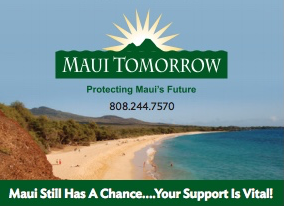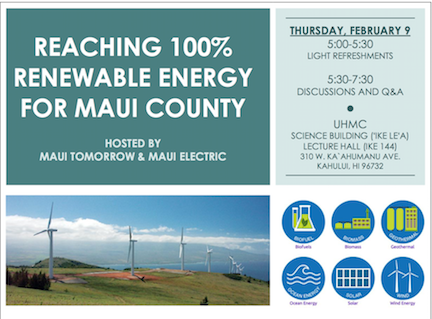Reproduced from Henry Curtis’ article at Disappeared News.
(Note Maui Tomorrow does not endorse any political party. We are reproducing this report on the Democratic Environmental Caucus meeting since it has interesting informational content. )
By Henry Curtis
Imagine going to a talk story where half the time is devoted to questions and answers. It’s almost unheard of. But it happened four times recently in Hawai`i. The gatherings were emceed by Gary Hooser.
On August 1, 2011 the Environmental Caucus of the Democratic Party of Hawaii held its last of four Community Conversation On Hawaii’s Energy Options. The speakers were
Kelly King (Pacific Biodiesel)
Robbie Cabral (Innovations Development Group)
Joshua Strickler (Public Utilities Commission)
Jeff Mikulina (Blue Planet Foundation)
Representative Denny Coffman (Chair, House Energy and Environment Protection Committee)
Senator Mike Gabbard (Chair, Senate Energy and Environment Committee)
Videos of the four conversations can be viewed at Ustream
Representative Denny Coffman (Chair, House Energy & Environmental Protection Committee)
“My big concern is that we really need to have, firm power, base power plant for the State, and its really something that has to trans[ition] in 5, 10, 15, 20 years and I don’t see the Hawaii Clean Energy Initiative doing that, and in fact, I’ve kind of come to the conclusion that sometimes when you put numbers out there like 70%, they can cause you to lose your eye on what you’re really, what’s your objective, and our statewide objective is not, just to get off of, fossil fuel, its really an economic problem we need to solve here. And so when you look at it as an economic problem, and then you take a look at what is going on in some cases, there’s a, there’s a rush to get off fossil fuels and the HECO companies are looking at a lot of biodiesel, and in some cases their looking at biodiesel, that I’m not even sure if there real projects, and I’m concerned because there’s biodiesel that’s coming out of Iowa out of animal fat, there’s palm oil, I don’t consider these that we want to have. Nor do I consider them, fuels that will solve our economic problem. Which takes us into the geothermal world.”
“The Big Island Biodiesel Plant and I just wanted to mention that is truly a community-based model because we got about 19 investor groups and they all live in the State of Hawai`i so we’re really proud of that.”
Robbie Cabral (Innovations Development Group)
“Why is IDGs approach important and different? Because IDG is committed, much more than what previous entities engaged in this industry have done in Hawai`i. Because IDG’s whole ethos, our reason for being is not just to extract a profit, but to return real value, real benefits, to the community. One of the recommendations that we make, when we forge a project, we have a working model, we have been doing it in New Zealand for the last 4 or 5 years. We have been working in New Zealand for the last decade plus with the various Maori tribes and trusts, in helping them to realize the potential value in development of their geothermal resources.
We have two working models in New Zealand right now that’s underway, one is heading into construction and the other one is heading into our permitting … What we have been doing in New Zealand is very similar to Hawai`i. We’ve been working with the native community. They have the same concerns as Native Hawaiians. They want to make sure that their, their whenua, their `aina, is protected and the development of it doesn’t in anyway hinder their ability to access of indigenous rights for subsistence.
And so we were able to put together a model that balances the commercial viability of a project, because at the end of the day, you have to go to the banks and borrow all this money. The average project that we’re working on right now is $200M. So our role with our Maori partners is to try to, we share the same concerns and putting into place the kind of protocols that they’re comfortable with and then balancing that with a commercial model the banks can live with.”
Question by Henry Curtis (Executive Director, Life of the Land)
“I was intrigued by something you said Jeff, about, resources being throughout the islands and we need to capture them, statewide, so do you support, or does Blue Planet support, the cable to Lana`i and Moloka`i and Maui as a first step to linking the islands?”
Jeff Mikulina (Blue Planet Foundation)
“You know we’ve been fairly silent on this issue, but from an engineering standpoint, we support using a cable to tap into the resources on the Neighbor Islands. Project by project we’ve been, you know fairly quiet but, I think we need all of the resources as soon as we can plug them in. The threat we face is so dire, so extreme, if we’re holding off for something that’s, going to be just around the corner in 30 years, then we have another thing coming so just looking at the population distribution and the resource distribution, I think we really have to be smart about where we’re going to plug them in, where we’re going to find the resources.”
Emcee Gary Hooser
“I have another one come in by text from Lance [Holter] on Maui for Jeff and Josh. It says ‘hey Gary why the emphasis on the underwater cable and industrial wind? Why not diversified renewables on all of the islands? Seems more sustainable and more secure.’”
Josh Strickler (PUC Chief Researcher)
“I don’t think we’re necessarily focused on industrial wind. If you go back and look at the recent PUC decision, regarding what was, I guess what was formerly known as Big Wind and Cable. We recently came out with a decision that said we’re looking for 200 MW of renewable energy from any island that can come to O`ahu or on O`ahu, so I think we’re trying to break that distinction that we’re only focused on one energy resource so, if Robbie [Cabral] wants to build a geothermal plant on the Big Island and lay a cable to O`ahu, go right ahead and put in your bid to HECO, the same thing for Maui.”
Jeff Mikulina (Blue Planet Foundation)
“You said the emphasis on industrial wind and I just fear when you start using these pejorative sort of things instead of industrial solar or what, industrial biofuel, Kelly, or industrial distributed generation, these mainland companies coming like Solar City that are making a lot of money doing distributed generation. I think we just have to focus on ending industrial oil, industrial fossil fuel that needs to be the threat that we keep on looking at over and over, it’s true though, I mean our resources are spread across the islands. We’re interested in what we can get into the ground as quick as possible to solve this problem, and wind is very affordable. Hopefully we’re have some more geothermal on-line, some more large scale solar as well, but we should be focused on everything, and I worry that particularly with the progressive community that we sometimes, sometimes eat our young you know, and we have these great ideas, we’re all progressive and when it gets close, and we say, ugh. … I just hope we focus on the prize which is ending fossil fuel, making Hawai`i a model for energy independence.”
Mary Guinger (Democratic Party Environmental Caucus)
“Gary [Hooser] started this thing when he said there seems to be …an argument between having small systems, local systems versus central systems, large systems. Now after hearing all of these, all of you people for all these meetings, I would like to have a standard that every island would know, how much, how much energy they can produce locally, and other options that they have for their island. And they, each island, each population in their island will decide, what is the best combination for them. I do think that the decision of energy should be among the people per island instead of utilities and big names and stuff like that. It should be up to the people.”
Kelly King (Pacific Biodiesel)
“I just wanted to make a comment thanking Mary for your comments. Part of my perspective comes as a resident of a Neighbor Island. I totally agree with what you said that the communities should look at their resources and decide. And the push back on the cable idea comes not from whether, or how fast it could happen but comes from two things. One, that the options are not being talked about on each island. Somebody’s making the decision that this is the way to move forward, and the other thing is that if we look at who’s going to own the cable its not going to be.
It’s the all of the components of a renewable energy portfolio have to do with these different companies that are emerging in Hawai`i, owned by people in Hawai`i, run by people in Hawai`i, for people in Hawai`i and so when you get into. I know Lance [Holter] and I think this is what he was getting at when he talks about industrial is, is a mainland corporation, an international corporation owning our energy resources, whether its a windmill or a solar farm, is that any better than us importing oil. So that’s the thing to think about is the economy still staying here if somebody on the mainland is running our windfarms and the profits are still going back to the mainland so I would just like to offer that, yes there are resources on every island, every community should decide how those resources and whether they should tie in together. When I came into the issue of the underwater cable it almost seemed it was already a decision that was made at some level so, I think that is a lot of the public reaction.”
Senator Mike Gabbard (Chair, Senate Energy & Environment Committee)
“Essentially what we’re talking about here how do we reach that goal of 70%, of the Hawai`i Clean Energy Initiative? And I agree with Jeff, I agree with Robbie, I also agree with the other Robbie, Robbie Alm of HECO in saying that we are going to need every wind turbine big and small, every solar panel, every, all the hydro, OTEC, wave, biofuels to reach this goal, oh, and yes, of course I shouldn’t forget geothermal. …For those of you in the energy community, you know, while we talk about these Big Sexy projects, quote unquote Big Wind, 200MW here, 200MW there, that I’m a DG [Distributed Generation] guy, that I’m into decentralization.”


